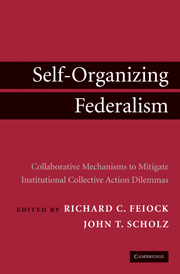 Self-Organizing Federalism
Self-Organizing Federalism Book contents
- Frontmatter
- Contents
- List of Figures
- List of Tables
- Contributors
- Preface
- PART ONE SELF-ORGANIZING VERSUS CENTRALIZED SOLUTIONS TO INSTITUTIONAL COLLECTIVE ACTION PROBLEMS: THEORETICAL CONSIDERATIONS
- PART TWO INTEGRATING METROPOLITAN SERVICE PROVISION: NETWORKS, CONTRACTS, AGREEMENTS, AND SPECIAL DISTRICTS
- PART THREE INTEGRATING REGIONAL POLICIES THROUGH NETWORKS, JOINT VENTURES, AND PARTNERSHIPS
- PART FOUR SELF-ORGANIZING GOVERNANCE AND INSTITUTIONAL COLLECTIVE ACTION
- References
- Index
Preface
Published online by Cambridge University Press: 29 January 2010
- Frontmatter
- Contents
- List of Figures
- List of Tables
- Contributors
- Preface
- PART ONE SELF-ORGANIZING VERSUS CENTRALIZED SOLUTIONS TO INSTITUTIONAL COLLECTIVE ACTION PROBLEMS: THEORETICAL CONSIDERATIONS
- PART TWO INTEGRATING METROPOLITAN SERVICE PROVISION: NETWORKS, CONTRACTS, AGREEMENTS, AND SPECIAL DISTRICTS
- PART THREE INTEGRATING REGIONAL POLICIES THROUGH NETWORKS, JOINT VENTURES, AND PARTNERSHIPS
- PART FOUR SELF-ORGANIZING GOVERNANCE AND INSTITUTIONAL COLLECTIVE ACTION
- References
- Index
Summary
Fragmentation of formal authority and the self-organizing activities to resolve the collective problems imposed by fragmentation are enduring traits of governance in the United States (Tocqueville2003). As policy problems and underlying resource systems become increasingly interconnected, the decisions of one government or independent agency inevitably affect outcomes of concern to the other units. In contemporary societies, the scope and magnitude of unconsidered positive and negative externalities increase as technologies extend the nature and number of public goods while growing economies and populations strain the limits and interconnections of natural systems, particularly in areas where rapid development and growth exceed the capacities of natural systems and therefore dramatically magnify interactions between different policies and authorities (Scholz and Stiftel 2005). This imposes collective action dilemmas on government authorities similar to those much-studied problems for individuals. The costs that these institutional collective action (ICA) problems impose on local actors have generated intensive search for institutions that can coordinate decisions across interdependent policy arenas without threatening the stability and advantages of our decentralized federalist political system.
Recognition of this problem brought the editors together to ask what mechanisms have evolved for dealing with fragmented authority and the resultant collective action problems, and what we know about them. Stated another way, how can local authorities organize themselves to obtain collective benefits of policy coordination when faced with uncertainty and commitment problems associated with collective dilemmas?
Feiock and Scholz have been independently working on issues related to this question for several years.
- Type
- Chapter
- Information
- Self-Organizing FederalismCollaborative Mechanisms to Mitigate Institutional Collective Action Dilemmas, pp. xv - xxiiPublisher: Cambridge University PressPrint publication year: 2009
